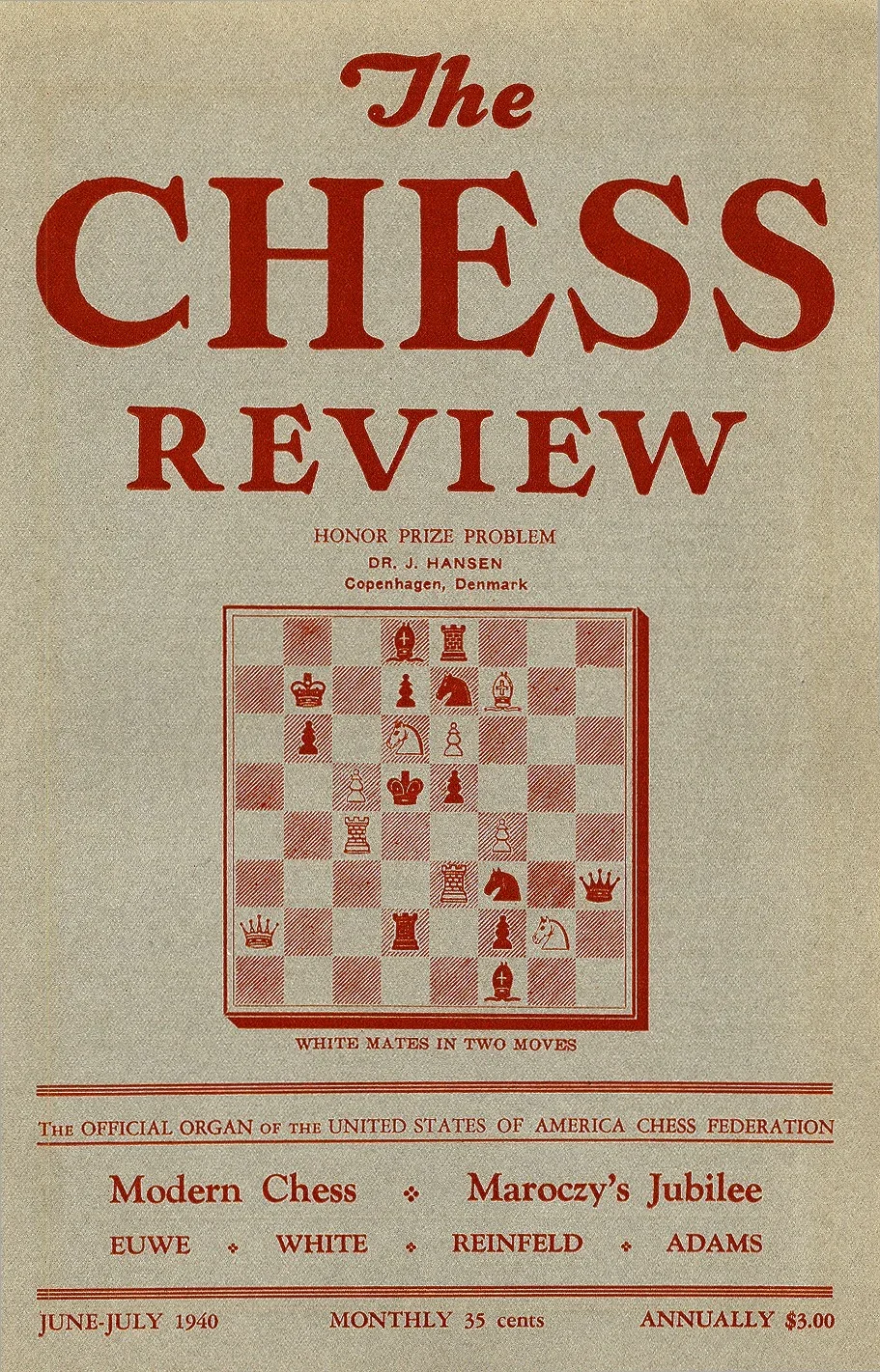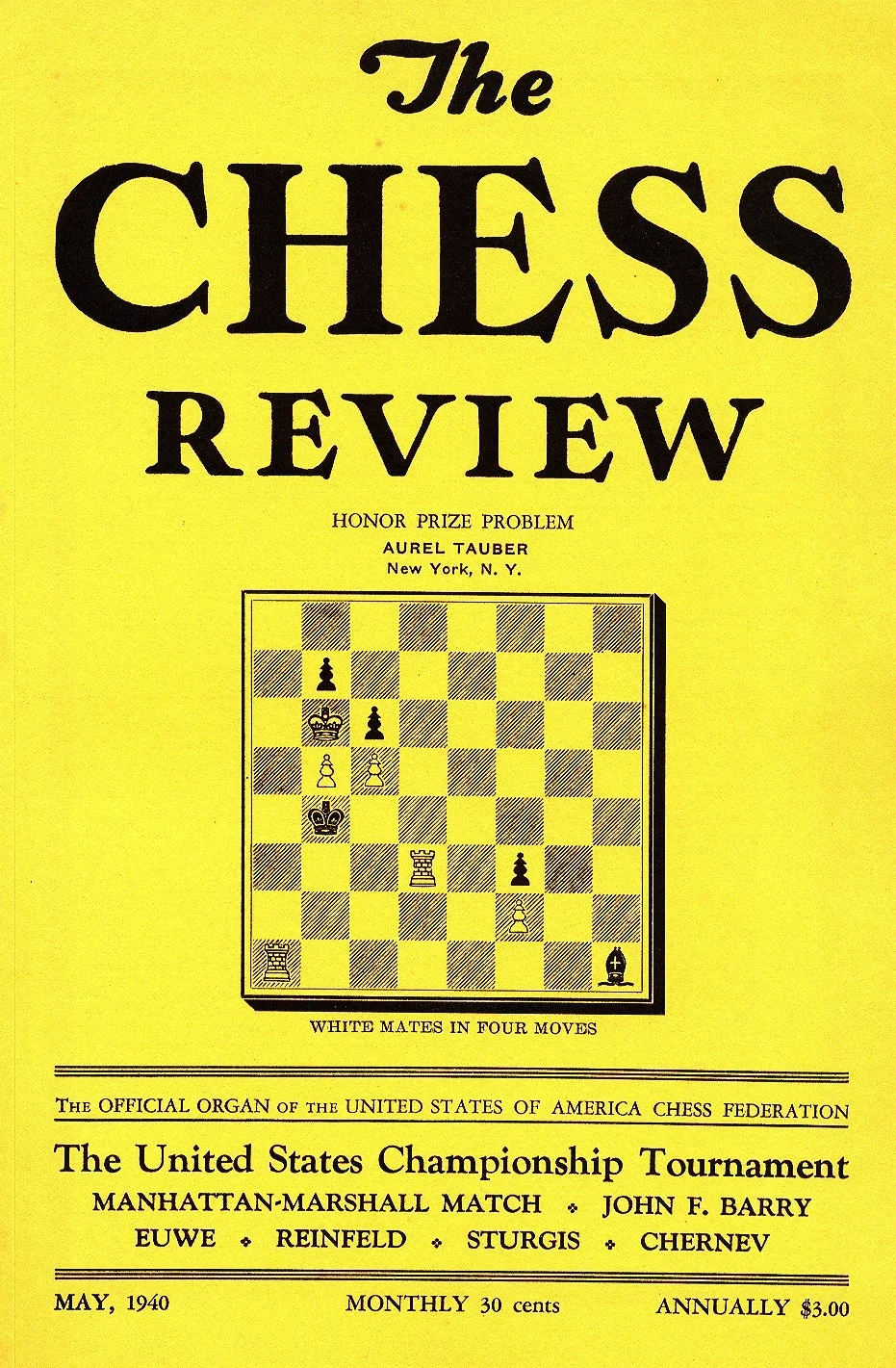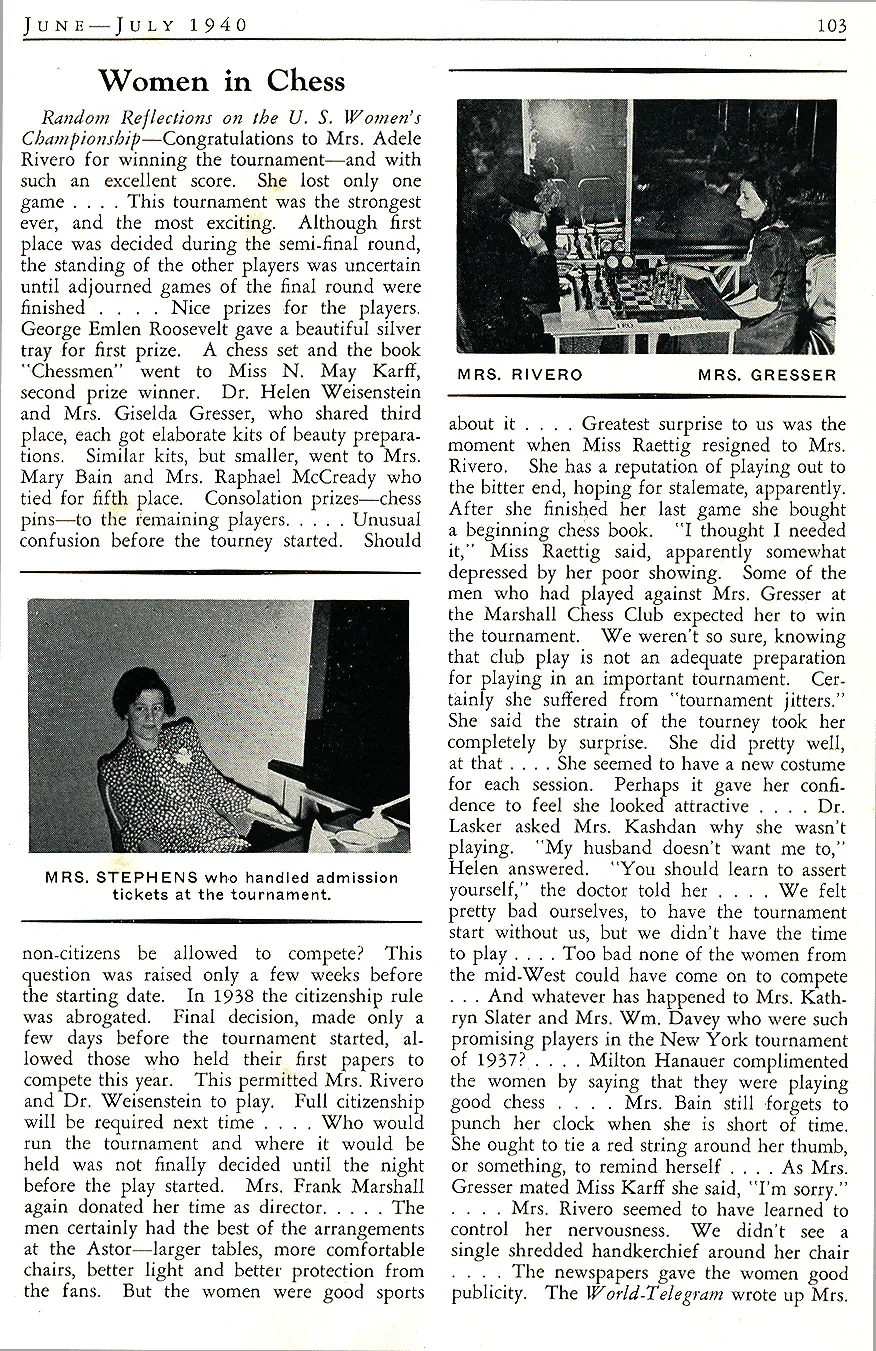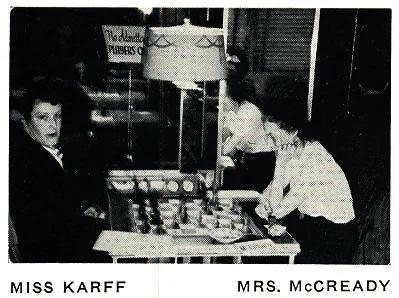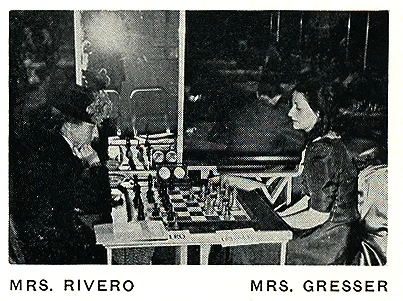This year marks the 80th anniversary of US Chess. Born of a merger between the American Chess Federation and the National Chess Federation on September 5, 1939, the nascent United States Chess Federation struggled in its early days. There was no Chess Life (until 1946), and membership was low. The total member base was reported as roughly 1000 players at the 1940 U.S. Open in Dallas.
The first U.S. Championship organized under the auspices of the USCF took place in April and May of 1940 at the Hotel Astor in New York. There was a 17 player field for the Championship, won by Sammy Reshevsky by a half-point over longtime rival Reuben Fine. There was also a nine person Women’s Championship, which was won by Adele Rivero.
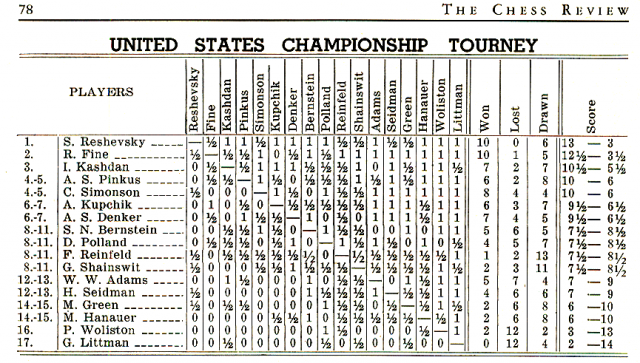 1940 US Championship Standings
1940 US Championship StandingsWhen we look back at the 1940 Championship, the key final round matchup between Fine and Reshevsky is certainly the most studied and heavily analyzed. Reinfeld treats it in the May 1940 issue of Chess Review, and Santasiere annotated it for the American Chess Bulletin. Analysts generally agree that Fine missed his chance to win on his 27th move, and the drawn game gave the title to Reshevsky.
[pgn] [Event "USA-ch03"] [Site "New York"] [Date "1940.05.19"] [Round "17"] [White "Fine, Reuben"] [Black "Reshevsky, Samuel Herman"] [Result "1/2-1/2"] [ECO "C59"] [PlyCount "124"] 1. e4 e5 2. Nf3 Nc6 3. Bc4 Nf6 4. Ng5 d5 5. exd5 Na5 6. Bb5+ c6 7. dxc6 bxc6 8. Be2 h6 9. Nf3 e4 10. Ne5 Bd6 11. f4 Qc7 12. O-O O-O 13. Nc3 Bxe5 14. fxe5 Qxe5 15. d4 exd3 16. Qxd3 Ng4 17. Bf4 Qc5+ 18. Kh1 Nf2+ 19. Rxf2 Qxf2 20. Rf1 Qh4 21. Qd6 Bg4 22. Ba6 Bc8 23. Bd3 Be6 24. Qb4 Qh5 25. Bc7 Nc4 26. Bxc4 Qh4 27. Bf4 Bxc4 28. Qxc4 g5 29. g3 Qg4 30. Qxc6 gxf4 31. Rxf4 Qe6 32. Qf3 f5 33. Qd5 Rae8 34. Kg2 Qxd5+ 35. Nxd5 Re2+ 36. Rf2 Rxf2+ 37. Kxf2 Kf7 38. c4 a5 39. b3 Re8 40. a3 Rc8 41. Nc3 Ke6 42. Ke3 Ke5 43. Kd3 Rb8 44. Nb5 Rd8+ 45. Kc2 h5 46. b4 axb4 47. axb4 h4 48. c5 hxg3 49. hxg3 Kd5 50. Kd3 Rg8 51. Nc3+ Kc6 52. Ne2 Rg4 53. Kc3 Kd5 54. Nf4+ Kc6 55. Kc4 Rxg3 56. b5+ Kd7 57. Kd5 Rg1 58. Nd3 Rd1 59. Kc4 Rb1 60. Nf4 Rb2 61. Nd5 Rb1 62. Nb6+ Kc7 1/2-1/2 [/pgn]Third place went to Issac Kashdan, a player who (in my opinion) is unjustifiably neglected in today’s histories of American chess.
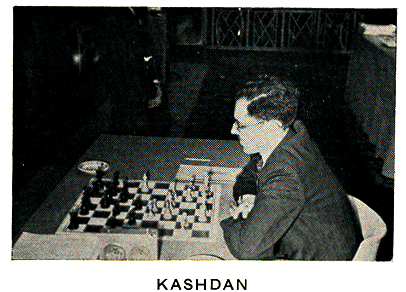 Issac Kashdan (Chess Review, May 1940)
Issac Kashdan (Chess Review, May 1940)Kashdan first came to prominence in 1928 when he won the individual gold medal as first board for the United States in the Chess Olympiad, and he successfully competed in many international tournaments in the 1930s. After his tournament days were over, Kashdan served Caïssa through his writing and organizing. Kashdan founded the Chess Review with I.A. Horowitz in 1933. He penned the chess column for the Los Angeles Times from 1955-1982, and he was instrumental in organizing the Piatigorsky Cups and the Lone Pine tournaments. Two Kashdan games are presented in the June-July 1940 issue of Chess Review. One is annotated by Weaver Adams, who defeated Kashdan in round 14. Fred Reinfeld, who finished in the middle of the pack in the event, does the honors for the Kashdan-Kupchik encounter from the first round. Both are presented here in ‘translated’ form, from descriptive to algebraic, and with the original notes. There are analytical errors – can you find them?
[pgn] [Event "USA-ch03"] [Site "New York"] [Date "1940.05.15"] [Round "14"] [White "Adams, Weaver Warren"] [Black "Kashdan, Isaac"] [Result "1-0"] [ECO "C14"] [Annotator "Adams"] [PlyCount "71"] {This game was awarded the prize for the most brilliant game beginning with 1. e4.} 1. e4 e6 2. d4 d5 3. Nc3 Nf6 4. Bg5 Be7 5. e5 Nfd7 6. Bxe7 ({The latest analysis purports to show a favorable game for White by} 6. h4 {(the Alekhine-Chatard Attack). But I am not over-familiar with this line, and besides, that Kashdan permits it does not speak highly in its favor.}) 6... Qxe7 7. Bd3 (7. Qd2 {or}) (7. f4 {is more usual, but I am convinced that 7.Bd3 is the strongest move, though it opens to Black extreme complications, if he chooses.}) 7... a6 8. Nce2 c5 9. c3 Nc6 10. Qd2 O-O 11. f4 f5 12. Nf3 b5 13. O-O Bb7 {Throughout the game Black suffers from the ineffectiveness of his queen's bishop, a characteristic of this variation.} 14. h3 c4 ({Slower but more deadly than the alternative} 14... cxd4 {. The attacks on both sides are slow in developing, but as usual in such cases fireworks are promised when they finally culminate.}) 15. Bc2 b4 16. g4 g6 17. Ng3 a5 18. gxf5 gxf5 19. Kh2 Kh8 20. Rf2 {Providing for Rg1 before Black can play ...a4 and ...b3} Rg8 21. Rg1 a4 22. Rfg2 a3 23. Ng5 Raf8 ({Sacrificing the b-pawn, but to resolve the queenside pawn situation by} 23... bxc3 {would leave White free to continue his attack on the kingside via Nxe6 followed by Bxf5 et c.}) 24. cxb4 h6 { This move has been criticized because it forces White into an apparently sound sacrifice. Yet if Black had not made this move, White would simply have consolidated his b4 pawn, and then have played for the ending with a pawn to the good.} ({Of course if} 24... Nxb4 25. Nxf5 exf5 26. Qxb4 $1) 25. Nxe6 Qxe6 26. Bxf5 Qe7 ({Not} 26... Rxf5 $2 27. Nxf5 Rxg2+ 28. Qxg2 Qxf5 29. Qg7#) 27. Bxd7 Qxd7 28. b5 $1 Nd8 ({Relatively better was} 28... Ne7 29. f5 Nxf5 30. Nh5 Rxg2+ 31. Qxg2 Qxb5 $1 32. b3 $1 Qd7 (32... cxb3 $2 33. Nf6) (32... Bc8 33. Nf4 ) 33. Nf6 Qf7 34. b4 Bc8 35. Qd2 {etc. with intriguing possibilities.}) 29. f5 Qh7 30. e6 {Now White's pawns become irresistable.} axb2 31. Qxb2 h5 32. Qe2 h4 33. e7 Re8 34. Qe5+ Qg7 35. f6 Qf7 36. Nf5 1-0 [/pgn]
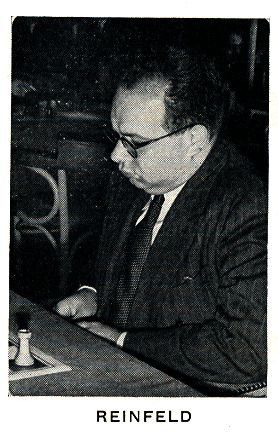 Fred Reinfeld (June-July 1940 Chess Review)
Fred Reinfeld (June-July 1940 Chess Review)[pgn] [Event "USA-ch03"] [Site "New York"] [Date "1940.04.27"] [Round "1"] [White "Kashdan, Isaac"] [Black "Kupchik, Abraham"] [Result "1-0"] [ECO "C42"] [Annotator "Reinfeld"] [PlyCount "73"] [EventDate "1940.04.27"] [EventType "tourn"] [EventRounds "17"] [EventCountry "USA"] [SourceTitle "HCL"] [Source "ChessBase"] [SourceDate "1999.07.01"] [SourceVersion "2"] [SourceVersionDate "1999.07.01"] [SourceQuality "1"] 1. e4 e5 2. Nf3 Nf6 3. Nxe5 d6 4. Nf3 Nxe4 5. d4 d5 6. Bd3 Be7 7. O-O O-O 8. c4 Nf6 ({Perhaps} 8... c6 {was preferable, all the more since Black's later ... Nc6 turns out to be of little value.}) 9. Nc3 Nc6 ({But here} 9... dxc4 10. Bxc4 Nbd7 {(to be followed by ...Nd7-b6-d5) was definitely better.}) 10. c5 $1 {Leaving Black with a terribly cramped game.} Bg4 11. Be3 Qc8 12. Re1 Re8 13. h3 $1 Be6 ({White's last move forced Black to renounce one of the QB's two diagonals. Thus} 13... Bh5 {maintains the pin, but then} 14. Bb5 {is very awkward.}) 14. a3 Nb8 {Bravely admitting that the development of the queen's knight was wrong.} ({Black is in a terrible quandry, for if} 14... a6 15. b4 { followed by the usual queenside advance is strong;}) ({while if} 14... a5 15. Bb5 {is again annoying. The text avoids these difficulties, but the harm done to Black's develpment is irreparable.}) 15. Qc2 c6 {...h6 would prevent the following move, but would weaken the kingside.} 16. Ng5 g6 ({Not} 16... h6 17. Nxe6 fxe6 ({if} 17... Qxe6 18. Bxh6) 18. Bg6 {and Black's king-pawn is not long for this world.}) 17. Nxe6 Qxe6 18. Bg5 Qd7 {Black is burdened with one disagreeable situation after another.} ({If} 18... Qc8 $2 {(in order to make way for the queen's knight)} 19. Rxe7 Rxe7 20. Bxf6 {etc.}) 19. Re3 Bd8 20. Qe2 Rxe3 21. Qxe3 Nh5 22. Re1 Bxg5 23. Qxg5 Ng7 24. Re7 Qd8 {The exchanges of the last few moves have failed to eliminate the pressure. White now wins a pawn, while Black still struggles with his development.} 25. Qf6 Qf8 26. Rxb7 Ne6 27. b4 Qg7 28. Qxg7+ Kxg7 29. Ne2 a5 30. b5 cxb5 {Now White has a passed c-pawn, and the d-pawn cannot last long.} 31. Bxb5 Na6 32. Bxa6 {Kashdan exchanges a bishop for a knight! There must be a reason! [Editor's note: Kashdan was well known for his love of the bishops. Arnold Denker once wrote that while Kashdan was often called "der kleine Capablanca" for his endgame skill, he might better have been dubbed "der kleine Janowski," as Janowski shared the love for the bishop pair.]} Rxa6 33. Rd7 {There is a reason. Now the queen pawn falls, leaving White two connected passed pawns to the good.} Ra8 34. Rxd5 Rb8 35. c6 Rb2 36. Re5 Nc7 37. Nc3 {An admirably clear and simple game by Kashdan. Black had no real chance after getting so cramped a position in the opening.} 1-0 [/pgn]
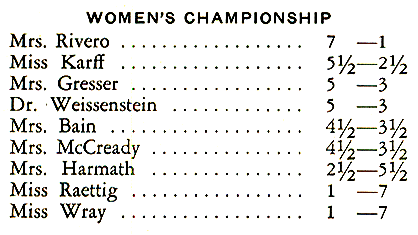 The Women’s Championship ran alongside the Open Championship, although it was certainly something of an afterthought for the organizers. Writing for the New Yorker, Robert Lewis Taylor described the Women’s event as being contested on “four card tables set up on part of the terrace.” As with the Open tournament, a series of qualifiers produced the field for the Finals, and John Hilbert does an excellent job of sorting through all the details in his masterful study of the event, The United States Chess Championship: New York 1940. His book is also one of the few sources on the Women’s Championship and women’s chess more broadly in the era. There are also two pages on the event in the June-July issue, and they are reproduced here. How times have changed!
The Women’s Championship ran alongside the Open Championship, although it was certainly something of an afterthought for the organizers. Writing for the New Yorker, Robert Lewis Taylor described the Women’s event as being contested on “four card tables set up on part of the terrace.” As with the Open tournament, a series of qualifiers produced the field for the Finals, and John Hilbert does an excellent job of sorting through all the details in his masterful study of the event, The United States Chess Championship: New York 1940. His book is also one of the few sources on the Women’s Championship and women’s chess more broadly in the era. There are also two pages on the event in the June-July issue, and they are reproduced here. How times have changed!
The Women’s title was won by Adele Rivero, who finished ahead of Mona May Karff by 1.5 points. Rivero also defeated Karff in their individual encounter, where (per Chess Review) “Mrs. Rivero disposes of her most formidable opponent by admirable endgame play.” Presented here, the game is the only remaining score from the 1940 Women’s Championship.
[pgn] [Event "US Women's Championship"] [Site "?"] [Date "1940.04.28"] [Round "2"] [White "Rivero, Adele"] [Black "Karff, Mona May"] [Result "1-0"] [ECO "E19"] [PlyCount "115"] [SourceTitle "Chess Review / Hilbert"] [SourceDate "2019.03.20"] [SourceVersionDate "2019.03.20"] 1. d4 Nf6 2. c4 e6 3. Nf3 b6 4. g3 Bb7 5. Bg2 Be7 6. O-O O-O 7. Nc3 Ne4 8. Qc2 Nxc3 9. Qxc3 d6 10. Nh4 Qc8 11. Bxb7 Qxb7 12. Nf3 Nd7 13. Qd3 f5 14. Ng5 Bxg5 15. Bxg5 h6 16. Bd2 e5 17. dxe5 Nxe5 18. Qd5+ Qxd5 19. cxd5 Rae8 20. Bc3 f4 21. Rae1 Nd7 22. gxf4 Rxf4 23. f3 a5 24. Rf2 Re7 25. Rg2 Nc5 26. Rd1 Kh7 27. Rd4 Rff7 28. Rdg4 Nd7 29. Kf2 Nf6 30. Bxf6 Rxf6 31. h4 Kg8 32. e4 Rff7 33. Ke3 Kf8 34. Rf4 Ke8 35. Rxf7 Rxf7 36. f4 Kd7 37. Rg6 Re7 38. Kd4 Rf7 39. Rg4 c6 40. dxc6+ Kxc6 41. f5 Re7 42. Rg6 Kd7 43. h5 a4 44. b4 b5 45. a3 Kc7 46. f6 gxf6 47. Rxh6 Rf7 48. Rg6 f5 49. h6 Kc6 50. Rg7 Rf6 51. h7 Rh6 52. exf5 Rh4+ 53. Ke3 Kd5 54. Re7 Kc6 55. f6 d5 56. f7 Rh3+ 57. Kf2 Rxh7 58. f8=Q 1-0 [/pgn]Rivero’s reign did not last long. Karff defeated her 5-1 in a 1941 match to reclaim the title, one that she held seven times over her US Chess Hall of Fame playing career.
Categories
Archives
- December 2025 (26)
- November 2025 (29)
- October 2025 (39)
- September 2025 (27)
- August 2025 (29)
- July 2025 (43)
- June 2025 (25)
- May 2025 (24)
- April 2025 (29)
- March 2025 (29)
- February 2025 (20)
- January 2025 (24)
- December 2024 (34)
- November 2024 (18)
- October 2024 (35)
- September 2024 (23)
- August 2024 (27)
- July 2024 (44)
- June 2024 (27)
- May 2024 (31)
- April 2024 (51)
- March 2024 (34)
- February 2024 (25)
- January 2024 (26)
- December 2023 (29)
- November 2023 (26)
- October 2023 (37)
- September 2023 (27)
- August 2023 (37)
- July 2023 (47)
- June 2023 (33)
- May 2023 (37)
- April 2023 (45)
- March 2023 (37)
- February 2023 (28)
- January 2023 (31)
- December 2022 (23)
- November 2022 (32)
- October 2022 (31)
- September 2022 (19)
- August 2022 (39)
- July 2022 (32)
- June 2022 (35)
- May 2022 (21)
- April 2022 (31)
- March 2022 (33)
- February 2022 (21)
- January 2022 (27)
- December 2021 (36)
- November 2021 (34)
- October 2021 (25)
- September 2021 (25)
- August 2021 (41)
- July 2021 (36)
- June 2021 (29)
- May 2021 (29)
- April 2021 (31)
- March 2021 (33)
- February 2021 (28)
- January 2021 (29)
- December 2020 (38)
- November 2020 (40)
- October 2020 (41)
- September 2020 (35)
- August 2020 (38)
- July 2020 (36)
- June 2020 (46)
- May 2020 (42)
- April 2020 (37)
- March 2020 (60)
- February 2020 (38)
- January 2020 (45)
- December 2019 (34)
- November 2019 (35)
- October 2019 (42)
- September 2019 (45)
- August 2019 (56)
- July 2019 (44)
- June 2019 (35)
- May 2019 (40)
- April 2019 (48)
- March 2019 (61)
- February 2019 (39)
- January 2019 (30)
- December 2018 (29)
- November 2018 (51)
- October 2018 (45)
- September 2018 (29)
- August 2018 (49)
- July 2018 (35)
- June 2018 (31)
- May 2018 (39)
- April 2018 (31)
- March 2018 (26)
- February 2018 (33)
- January 2018 (30)
- December 2017 (26)
- November 2017 (24)
- October 2017 (30)
- September 2017 (30)
- August 2017 (31)
- July 2017 (28)
- June 2017 (32)
- May 2017 (26)
- April 2017 (37)
- March 2017 (28)
- February 2017 (30)
- January 2017 (27)
- December 2016 (29)
- November 2016 (24)
- October 2016 (32)
- September 2016 (31)
- August 2016 (27)
- July 2016 (24)
- June 2016 (26)
- May 2016 (19)
- April 2016 (30)
- March 2016 (36)
- February 2016 (28)
- January 2016 (32)
- December 2015 (26)
- November 2015 (23)
- October 2015 (16)
- September 2015 (28)
- August 2015 (28)
- July 2015 (6)
- June 2015 (1)
- May 2015 (2)
- April 2015 (1)
- February 2015 (3)
- January 2015 (1)
- December 2014 (1)
- July 2010 (1)
- October 1991 (1)
- August 1989 (1)
- January 1988 (1)
- December 1983 (1)


